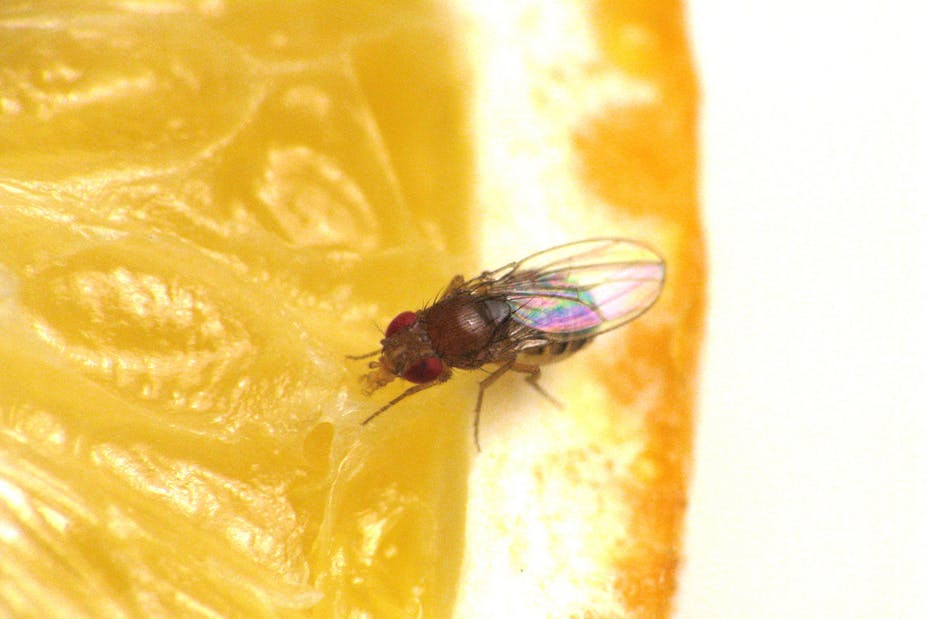You might think you don’t have much in common with a fruit fly. But studying them could tell us more about human conditions such as traumatic brain injury (TBI) - from, for example, a motorbike accident or a blunt hit on the head - which can in some lead many years later to chronic traumatic encephalopathy, an Alzheimer’s-like form of neurodegeneration.
We’ve been studying many aspects of neurobiology in flies: how neurons generate the electrical impulses used in nervous system communication, how they form proper connections (synapses) to relay information from one cell to the next and, more recently, neurodegeneration. We recently showed that over-activation of the innate immune response in the brain of flies can lead to neurodegeneration, which is also known to be a consequence of TBI in humans.
Buzzing around
It’s not the first time fruit flies have been used to study human disease. Seymour Benzer, one of the great neurogeneticists, was a pioneer of Drosophila neurogenetics - the application of genetic techniques in the Drosophila family of (fruit) flies to study neurobiology and behaviour.
Short-term effects from TBI such as motor incapacitation and ataxia (disorders that affect balance and co-ordination), and long-term effects like the onset of neurodegeneration can be seen in these flies - just as in humans. And flies have already been used as models for Alzheimer’s, Parkinson’s and Huntington’s diseases.
Concussions and TBI in humans are described mostly in terms of the symptoms. Unlike high blood pressure or diabetes or elevated cholesterol, there is no quantitative readout. This is where Drosophila models are so useful; we can do studies (underway) to look at which genes are activated or inactivated following a brain injury. This not only tells us more about underlying biological mechanisms, but also gives us biomarkers that can reveal the extent and severity of the injury.
We can also reproducibly inflict brain injury to large numbers of flies of a known genetic background. In other words, we can control all the variables so that we can find those changes in gene expression that correlate with the injury.
You and a fruit fly
At the level of individual cells, there is no fundamental difference between a nerve cell in a fly brain and a nerve cell in a human brain. Damage to a nerve cell from an impact injury shouldn’t differ in any fundamental way either.
Years of experience have revealed that the basic mechanisms and the genes and molecules that govern these mechanisms are highly conserved between flies and humans, which is now further demonstrated by comparing the genome sequence of flies and humans.
Flies have already been also used as experimental models for many complex neurobiological mechanisms and neurological disorders. For example, flies have been used as models in studies of sleep, circadian rhythm, addiction, alcoholism, epilepsy, learning and memory, and neurodegeneration. And much of the information gained from such studies have had direct and important impacts on our understanding of the related mechanisms in humans.
There is every reason (in my opinion) to believe that what we learn about nerve cell injuries in flies will be directly relevant to humans. Human brains are of course more complex, and the particular manifestation of various brain injuries on human activities such as speech, memory and so on are going to be different. But at the level of individual nerve cells the similarities are likely to be far greater than the differences.
Experimental models
We need to know much more about TBI. Every person’s brain injury is different and there are so many variables including the type and severity of the injury, the age of the individual and genetic variation among individuals.
But there are limitations to what studies can be performed on people to find out exactly what the immediate and longer term consequence of a particular injury are, which is why we need experimental models.
Existing models mostly use mice and rats. It isn’t that investigators using these models haven’t done many important studies and learned a lot. But there are still inherent limitations to what can be done with rodents because of the numbers you can deal with, the injuries that can be inflicted and the experimental tools that are available. With flies, we can easily control all the variables; we can work with extremely large numbers of individuals and we don’t have to wait months or years to observe long-term outcomes - we can see these after just several weeks.
The hope is that using the experimental tools that we have developed can unravel the underlying cellular and molecular mechanisms behind the short and long-term consequences of TBI. In the best of all possible worlds, an understanding of these mechanisms could help us find a way to treat or even prevent neurodegeneration, in athletes, for example, who may risk knocks to the head. Just as some individuals are more prone to heart disease or cancer or neurodegeneration depending on their genetic background, we’re trying to identify genes in flies that confer either sensitivity or resistance to TBI. It’s early days but there are some indications that genes that confer resistance to TBI are different in younger flies than in older flies.
Drugs that seemed promising in rodents have all failed in clinical trials. The reasons are probably numerous but certainly among them is that we’re dealing with so many variables. We are now in an era of personalised medicine, where we want to find the right drug that works best in a particular individual and differences in genetic makeup are likely to play an extremely important role.
In a word, TBI is complex. Our hope is to get a handle on this complexity using the humble fruit fly.

